The one handed pushup is an exercise that many are familiar with, but only within the confines of television and movies. Whether it be Bruce Lee or Rocky Balboa, millions of boys and young men have seen this nigh-superhuman feat and sought to perform it…only for their efforts to result in sore shoulders, popping elbows, and other maladies (one result they will certainly not achieve is the successful completion of a one-armed pushup).
Simply put, I doubt there is any person in the world who can do a one-handed pushup on their first try, for the simple fact that almost nobody is taught how. This article will start you upon the admittedly difficult road to this seemingly impossible feat.
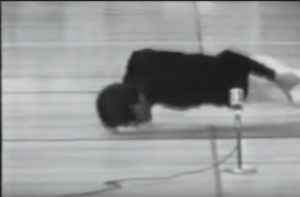
Bruce Lee doing a one handed, two finger pushup.
Some Biological Background
Resistance training should, ideally, train more than just the muscles—it should also strengthen the connective tissue of tendons and ligaments, and train the nervous system to work in conjunction with the skeletal muscles as the proverbial “well-oiled machine.” Muscle fibers connected to neurons from the nervous system are a “motor unit,” and to exercise is to train both the muscles to contract, and the nervous system to fire more powerful electrical impulses to the synapses, which in turn forces the muscles to contract more powerfully, etc.
When you do a particular exercise more frequently, you train the motor units that do that exercise to work more efficiently, which leads to you become stronger.
Why This Is Relevant
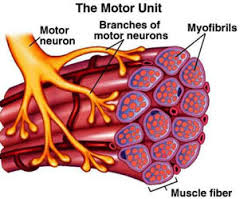
While most of us are well familiar with the standard two-handed pushup, this exercise alone cannot train the body to hold its weight on one arm. To do a one-handed pushup, you have to train your body (the muscles, the joints, and the nervous system) to become used to bearing the weight on one arm. Realistically, why would you expect to be able to do it immediately after training with two arms? Instead, you should take steps to gradually force the solitary arm to bear more and more weight, until the true one-handed pushup is done. But chances are, you don’t know the steps.
Once again, the public school system fails us all—rather than providing worthwhile coaching in any sort of athletics, gym class has us play stupid games involving paddles and furniture dollies. Or maybe it was just my school that played “pickleball,” I don’t know.

It wasn’t until college that I was fortunate enough to have instruction in proper calisthenics. Gradually I learned the progressive steps to increasingly more difficult push-ups, and after roughly a year of effort, I was capable of doing true one-handed pushups.
Why Calisthenics?
A question I get a lot is why bother doing calisthenics? Why not stick to weights? Certainly, I’m not anti-weight. I do extensive weight training as well, and I will eventually write instructional articles on various lifts. However, I feel that calisthenics are beneficial to all strength-training athletes, whether they are a total beginner or a veteran of the weight room.
High level calisthenics (one arm pushups, one leg squats, etc.) train the motor units to maximally exert themselves in an orientation totally alien to weight training. This can only make you stronger generally. In addition, they have almost no risk of injury compared to weights. They are in some ways more practical for daily life, and for the beginner, they provide a solid base of strength for future weightlifting.
It is my opinion that if you cannot manipulate your own body to a reasonable level, you have no business lifting weights—thus I always instruct people to start with calisthenics before starting with weights. Take my advice to whatever extent you want to, but my core thesis remains: you should incorporate calisthenics into your routine.
The Pushup Progression
Bear in mind that in all calisthenics you should do them relatively slowly and controlled, with proper form being upheld. And for pushups specifically, you lower yourself until your nose or chin (whichever you prefer) touches the ground.
The first pushup, which most of you will likely not need to do but I include for the sake of completion, is the knee pushup. Get on your hands and knees and slide your legs back until you feet and shins are off the ground, and you are only resting on your knees. Using the knees as a pivot, do a pushup. Once you can 10 of these, move on to the next step.
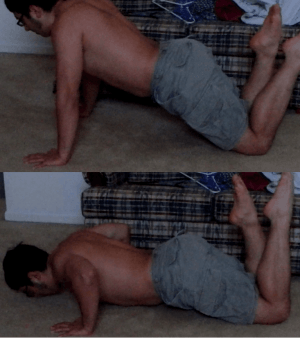
The second pushup is the standard you remember from gym class. Keeping the back straight and the hips and buttocks down, bend at the arms and lower your nose to the ground, then push up. Do that 10 times, and move on.
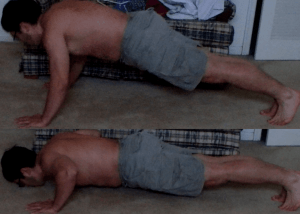
The third pushup is the diamond pushup: The hands are brought next to each other forming a diamond shape, and then the pushup is done as usual. If you find these difficult, you can gradually bring your hands closer together. In other words, from the standard pushup, move your hands a couple of inches closer, and then next time another couple of inches closer, etc. until you get to the true diamond form. Once you feel enough of the Illuminati power to complete 10 of these, move on.
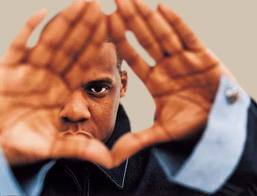
Jay Z’s pushup form or a call to Satan?
Following that, we have “one and a half” hand pushups. Put your hand on a basketball, or something the same size as a basketball (I stacked three books in the picture), and do a pushup. This handicaps the hand that is resting on the object, forcing the other hand to work harder. Do this for both hands. Once you can do 10 with each hand, move on.
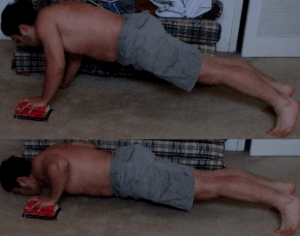
In contrast to one and a half hand pushups, we now have half one-handed pushups. This is, as the name implies, doing a one-handed pushup, but only going halfway down. Get in a one-handed push-up stance: spread the legs to shoulder width, put the resting hand behind the back, and balance on the other hand (keep the hips down of course). Then bend at the elbow, go as low as you can go, then push up.
This exercise is where the talk of the nervous system above comes into play—your body is simply not used to moving in this way, and you will almost certainly not be able to bend all the way down. Do this exercise with both hands until you can bend down all the way. You don’t need to push up, just bend down all the way with the one arm. Realize that your torso will not touch the floor as in the standard pushup, and your hips may “worm” up a little bit. Try to keep the latter to a minimum.
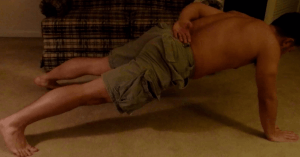
Supported one-handed pushups are a bit unusual, so unusual I don’t have a picture (thanks to Paul Wade’s Convict Conditioning for this one). It’s similar to the one and a half hand pushup, but with the supported arm being fully extended—put the supported hand on the basketball (it has to be a ball this time), and roll it out so the arm is extended. Then do a pushup, rolling the ball to your wrist and forearm. The key is not to bend the supported arm. When you can do this 10 times with both arms, you are ready to try the one-handed pushup.
The one handed pushup is, as one might assume, identical to the half one handed pushup: you just bend all the way down, touch your chin or nose to the ground, and bend all the way up. You want to avoid contorting your back or hips (pain will tell you when you’re doing this).
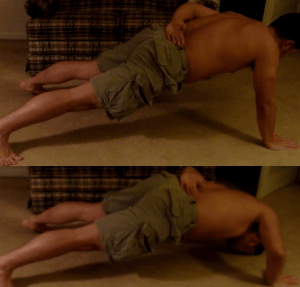
Once you can do the one-armed pushup, you can begin training repetitions for endurance.
This exact pattern of progressions also works with fingertip pushups, which I have trained to a one handed variation:
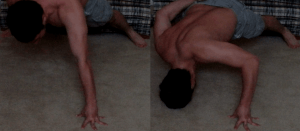
And the same general idea of gradually increasing to progressively harder variations a little bit at a time applies to all calisthenics in general—in effect, it is the bodyweight equivalent of adding weight to the bar. Good luck with your training, and see you next week.
Knee push ups… lol
Hey man don’t hate, haha. Before I started working out I was 19 years old and stick thin, couldn’t even do 5 pushups in a row without stopping.
http://4.bp.blogspot.com/–lfIixQyXNk/TqmIzp3EVKI/AAAAAAAAAj4/1AewXcyAAa0/s1600/trex.jpg
In high school I worked out nonstop. I did 26 one-armed push ups in gym class to impress a girl. She was impressed but didn’t blow me. On FB now I see she’s cut off her hair and gained 30 pounds. I’ve fucked hotter girls than her. Moral of the story: If you’re disciplined enough to do one armed push ups, you’re disciplined enough to learn game.
I didn’t realize the one armed push up was still a thing. 26 push-ups one handed is pretty impressive. Just showed a kid how to do one before he enrolled into the army a few months back. Almost all variants shown of the one armed push-ups are doable, including the close legged, however, they balance the body irregularly and do require a lot of practice to get right without using the swing out effect. The one finger push-up is still the Moby Dick of all push-ups to me. Never seen it and definitely haven’t done it.
A great pushup and good balboa device/modified Roman Chair routine. Thats what needs to be taught
Interesting you would say that. Back when doing multiple push-ups was a thing for me, the chair as an accessory was definitely part of my workout, in particular, the bar stool. It was high enough to allow for full dip range and sturdy enough to not topple over after a set of ten. They were never utilized for push-ups. For push ups I found your basic dinner table chairs as the best option. They felt like cheating after awhile as they held up most of my weight. Good point.
Was always partial to the push up and clap but now, the burpee style push up seems the way to go. Push-up, jump into a standing position, do a jumping jack, get back down and repeat. Does a number on your stamina.
I am not big on explosion in routine. Holding a pose and fluid motion.
I was taught the iron cross in school, where you hold push up position with your arms at right angles for a set period of time we were usually told to do it for 10 or 30 seconds Holding it for a minute or more was some times given out as a punishment by teachers when students misbehaved.
Wow, 26 one handed pushups and yet so shallow.
Moral of the story should be: you’re a pathetic attention whore
“Women are strongly discouraged from commenting here.”
go back to 69ing manic depressives sweetie the men are talking.
…..
I once took a bet with a chick and she was my sex slave for an hour for 10 one-arm pushups. All three holes.
A very specific article. I like it.
Well explained and informative.
I can do this.
Here, hold my beer.
Would you like your beer back now that you’ve popped your shoulder out?
Well put it back in; give me my beer; and send over them dockets.
I’m okay, I’m okay… tis but a scratch.
A scratch?! Your arm’s off!!!
No it isn’t!
Look!
Will stick with my garden tools for exercise. I am both looking forward to and dreading the effort. Spring is not far away.
Better make it 2
A couple of years ago I actually did try to do a one-armed pushup and jacked my shoulder up pretty good. I figured I could do them as a kid so why not now? Silly me.
Don’t forget to take your Kratom beforehand.
Dude, that’s so 2015.
Of course it’s 2015! Kratom holds back the flow of time!
Kratom win, lol
Lolz, Kratom is so awesome it uses Chuck Norris!
You’re teaching it wrong. The guy in the picture has the opposite leg extended for balance, because he is not as light as Bruce Lee. I know because I’ve been doing them for 25 years.
teach me senpai
assuming you are serious, here goes:
(from the article:)”Get in a one-handed push-up stance: spread the legs to shoulder width,
put the resting hand behind the back, and balance on the other hand
(keep the hips down of course). Then bend at the elbow, go as low as you
can go, then push up.” – bad advice.
First off, as I wrote, the guy in the picture has the opposite leg extended out. The only way you can get away with not doing this (as quoted wrongly above), is if you have superb triceps strength that you can put your single hand below your torso. The further your pushing arm is out, the farther out the opposite foot has to be placed, for balance. And depending on what part of your upper body is stronger, you might favor the push position that relies more on triceps, which is closer to your body; or you might favor having your hand out further, favoring the front deltoid and upper pectorals. At the extreme, this position would be a line drawn from your hand to your opposing foot, at about 30 degrees to your spine. Don’t measure it, just see what position you’re stronger at. Second, you might want to vary how much your elbow is angled outward, as opposed to keeping it tucked in next to your body (damn near impossible if you, again, don’t have the triceps for it). The farther out your elbow is, the more upper the pecs/deltoids work.
i was only half joking because you stated that he was wrong but didn’t offer any alternate advice so that comment was to get you to expound upon why you would type that. also, because i don’t know you, how can i just believe that you have X amount of years experience in one handed push ups just because you typed it.
Best pushup guideline I’ve ever heard: Do your own age every day, in one set.
Think about it. You challenge yourself MORE as you get older.
I’m 40 and can do 40, but only barely. Probably not gonna keep doing this to 60, I can tell you.
I used to do these and one-armed pull-ups for years, so a word of advice: don’t overdo it–you will develop *hellish* tendinitis if you don’t take some precautions, including, again, not overdoing it and taking things like cissus and glucosamine as part of your daily routine.
(This advice should probably go for anyone engaging in weight training in the decade-plus span, but the one-armed stuff will bring it on much more quickly if you don’t take precautions.)
I’m 29 I do 120 pushups every day. doesn’t make me bigger but at least works my muscles a little bit.
There’s something to be said for muscular endurance. That’s what I’m struggling on right now.
I can barely do 50 at 18
around 38 at 17 – time to get to work lol
Yep push ups become an endurance thing with incremental gains. That’s why people join the gym and start lifting. Time to bench press 5 sets, of 5 reps each.
Another argument for calisthenics: you can do it anywhere. If you’re travelling you can do a pretty good work out in your hotel room.
BTW, you’re already been targeted in Australia for your meet ups this weekend in Melbourne, Sydney, Perth etc.
http://www.theage.com.au/national/supporters-of-antiwoman-group-return-of-kings-to-meet-in-sydney-20160201-gmikrh.html
Well, that was to be expected. Roosh made a mistake by publishing locations of meetings.
Hah, they’re pushing the old “Roosh says rape should be legal!” schtick.
After reading through the comments, it’s apparent how ignorant most of these people are. Just mindless drivel of how Roosh approves legalizing rape and is inciting violence through these meet ups. It’s really quite pathetic. The only comments I saw with a level of intelligence and critical thinking were the ones supporting Roosh.
So australian newspapers are driving web traffic to ROK now?
Fellow ROK readers, I need your advice.
I recently started practicing Taekwondo, but there’s something that’s been bothering me. I have taken four classes so far, but all we do is fitness exercises and throwing kicks, no punches whatsoever. Don’t get me wrong- I’m still a newbie in TKD, but how can you defend yourself in a real fight situation, when all you do is just throw low, mid-high and high kicks? I want to learn how to fight and defend myself, not just perform some fancy kicks. What’s your take on this? Maybe someone who has solid background on TKD or any other martial art can help me out.
TKD, despite claims to the contrary, is not a centuries old martial art but a sport devised in the fifties by a Korean (General Choi) who had a blackbelt in Shotokan Karate. He modified the curriculum somewhat, but probably at that time it was pretty much straight Karate, nationalised as a Korean sport.
Its growing emphasis on competition along the years however, especially since it became an Olympic sport, has sadly moved it further and further away from its original roots of unarmed self defense. Nowadays it’s practiced almost exclusively as a sport.
The WTF Olympic rules disallow face punching completely! That alone shows you how far removed it is now from practical application. Learning how to deal with punches thrown at your face is fundamental, since in an altercation / self defense scenario, it’s practically a guarantee that an attacker will try to hit you in the face or head. I’m not saying that TKD is worthless, after all it also much depends on the philosophy of the instructor you study under. But if your training is completely confined to competition rules, you might want to look elsewhere if you want something that is more useful for self protection, rather than just an athletic sport.
You also need to have a mental framework by which to judge how much what you are being taught is relevant to self defense. No one system will give you all the answers. I highly recommend Marc MacYoung’s site to teach yourself how to look for the ‘gaps’ in what you’re doing. Check out the section titled “Are martial arts for self defense” especially.
http://www.nnsd.com/
It completely makes sense. The instructor guy who runs the gym is also the vice president of the Taekwondo Federation in my country, hence his interest in recruiting as many people as possible. Don’t get me wrong, though- he is good and knows his shit, but as you mentioned, it’s a quite rigid sport, with no room for creativity or new techniques. What martial art do you recommend?
Very hard question to answer, my friend 🙂 It depends mostly on how you are taught and the focus of the instructor. Hence you can find great instructors as well as hacks in any martial art. What I could share are some things to look out for, which you can use to roughly judge any martial art club you may consider joining.
Think of it in terms of ‘what would make a good racing car?’ as an analogy. Different brands of cars will differ in design details, but in broad terms they all need to meet certain standards. The engine has to have a certain level of performance. The frame, transmission, suspension, tyres .. all have to be up to withstanding the stress of car racing. It cannot have glaring weaknesses. With this in mind, you can evaluate and judge fairly accurately anything you encounter.
Is this something which I could use effectively in the street? Or would this actually endanger me and therefore I should avoid it? Different arts will have stylistic differences, but all effective ones will share certain common attributes. I would look out for these factors:
1) Many arts have a preferred ‘range of engagement’. It’s important to know yours, and evaluate what gaps you are left with. Broadly speaking, there are arts that focus mostly on very close, grappling range – all the type of wrestling arts out there – and other arts that focus mostly on striking. The latter can also be subdivided into striking arts that prefer long range fighting, or in-fighting. Principle: what you train most is what you’ll become good at. What you don’t train to defend against, will be your weakness. Some examples:
TKD relies mostly on longer range kicking. This means that if that’s all you do, you’ll be weak at punching and grappling range. Conversely, a wrestler will be comfortable up close once he has his hands on you, but his weakness will be against fast striking combinations that keep him at bay.
Boxers are masters at the medium to infighting hand range, but their weakness is against grappling and longer range fighting, and being attacked below the belt and from behind, since they don’t train against it.
Having said that, I would consider a good level of punching / hand striking ability as a must. They are the most accessible and flexible weapons, and the ones you’re very likely to face if someone attacks you in the street. So two of your primary goals should be knowing how to throw an effective punch (closed fist or otherwise) that can stop an opponent, and being able to defend against someone trying to punch your head off. I would consider these essential skills. You can then round off your skill set with some grappling skills and a few good kicks and longer range footwork.
2) Does your art focus on “effective body movement”? Whatever power you’ll be able to generate in your striking (and how effective your grappling moves will be if you do grapple), will depend on how skillfully you move your body. An art that goes into great detail into body movement, balance, power generation, body alignment and structure, weight distribution, movement of body mass and momentum, tension and relaxation, and proper distancing for each technique, is a quality art with a sound foundation. You are only as good as your fundamentals. So look for someone who puts a lot of emphasis on the fundamentals. Avoid those who don’t seem to pay them enough attention.
3) Does what you are being taught rely on solid fundamentals as explained above, or does it rely on plain aggression and strength? This is a “patch” you will see frequently. Many try to compensate a lack of good body movement with plain muscles and aggression. It might work (sometimes) if you happen to be a young, very big, very powerful dude with a high pain tolerance. But you’ll be mince meat if you depend on pure strength and aggression when facing someone who’s even stronger and meaner than you. So if (like me) you are not a hulk, stay away from that and learn something which you can use to defend against someone bigger and stronger, ie something which does not depend purely on strength and aggression.
A good way to tell if what you are being taught depends too much on size and strength, is if it has you facing opponents squarely and trading blows all the time. In that scenario, the stronger one and the one most able to absorb punishment will usually win. But it exposes you to a lot of damage, and could be suicidal if you don’t happen to be someone who’s bigger, stronger and meaner than 90% or more of people out there. Conversely, look for someone who can teach you how to neutralize an attack, how to destroy his capability to keep attacking, how to *move out of the line of attack* (very important), and how to defeat a stronger opponent with superior positioning and tactics, and *not* by soaking up his attacks with your body and face.
3) Does what you are being taught depend too much on the protection given by competition rules? Rules which are not there if you are attacked on the street?
Your TKD that does not train you to handle being punched to the face, is one obvious example. Every art has a bit of that since most have their preferred engagement range. But look out for moves which would directly endanger you once the rules are not there. Eg. the TKDist who moves in with his face recklessly exposed because he never gets punched to the face in training, or the ground fighter who likes taking it to the ground because in training he cannot be stomped by multiple opponents or be kicked in the nuts or have his ear bitten off.
Here’s something to keep in mind: whatever the competition / training rules forbid, will be a weakness. Of course rules are there for a reason. No one wants people to die in training or competition. You cannot do without rules. Just be aware to think outside the confines of the rules your are used to.
4) Self defense is much much more than “knowing how to fight”, and is mostly about the right mental attitude and a lifestyle that minimizes risk. Studing Marc MacYoung’s site which I linked to previously will be a great investment in your safety.
I hope this is of help 🙂
EDIT: A couple more points to think of. Consider also how your build affects what you do. If you happen to be tall and have long limbs, kicking and long range punching will suit you well. If you are more the ‘barrel type’, infighting and wrestling will probably suit you better than trying to learn moves that require the athleticism of a gymnast. So that’s something to consider.
Also, evaluate what you are being taught from the environmental aspect. It’s one thing to pull off certain moves in a comfortable, well lit, padded dojo. It’s something else to perform outside in the dark, on a slippery or rough surface, and in street clothes and shoes. So that’s important to consider too. Can you apply what you are being taught in less than ideal conditions?
Thanks a lot bro. I am an athletic guy, have a visible six-pack, but I find it hard to master even the most basic kicks in TKD. How’s that possible? I’m a naturally left-footed guy, which makes it difficult for me to throw decent kicks with my right leg. Some kids there make me feel like a total noob in TKD, which technically I am. I swear, it’s funny and disheartening at the same time. I’m no quitter, though. I will stick with it, till I make TKD my bitch. I know, that’s easier said than done, but I won’t give in without a good fight.
If you find a good and practical internal martial art teacher like aikido, Bagua, xinyi, Taichi you can learn striking to grappling well(aikido is more submission based, few strikes, but these days some of them ain’t that good and focused too much on forms and not enough Interactive exercises or they ain’t that good. But internal is slower often you focus on the fundamentals for a while before going to two man exercises and more focused on relaxation.
5th degree in TKD here. TKD originally was a more comprehensive fighting style including more emphasis on punches and even throws. Over the years, it has evolved to specialize primarily in kicks and that what most schools will focus on. It is great for developing a good level of fitness, kicks, and footwork, but like you’ve experienced, it is lacking in other fields. I would suggest finding a school that teaches multiple styles (by competent instructors) and learn TKD and something to shore up the gaps. Good luck on your journey.
Thank you man. Yeah, my legs feel a bit sore, but I’m getting used to it. I would love to find another school that teaches something more comprehensive, as you recommend, but I have limited options(most gyms in my area are full of guys who just lift and that’s all). On the other hand, I don’t wanna quit. Plus, I can’t afford practicing two martial arts at the same time. I’ll stick with TKD for the time being, do some shadow boxing at home, and later see what I can do. What about Muay Thai? Here’s some info about me. I’m 5ft9 and weigh only 132 pounds. While most people are desperate to lose weight, I’ve been struggling to gain weight my whole life. I’ve been playing sports since I was a kid, mainly football(soccer), tennis and a bit of parkour. I consider myself fit, although some would say I’m skinny, but I don’t mind. Here’s the thing, though: I find myself losing balance when performing some difficult kicks in TKD. How can I improve my overall performance?
I’ve been taking Israeli Combat System (krav maga) classes for the past seven months or so. It’s not nearly as pretty as TKD, but it does definitely give you the tools to defend yourself. Along with A LOT of fitness conditioning, the yellow (beginner) level includes your basic punch combinations and how to defend against them; alternate strikes like hammerfists, eye gouges, and palm heel strikes; several types of kicks; breaking chokeholds and headlocks; combat rolls; fall breaks; ground fighting position; recovery from the ground; and much more (I had a three page list of skills required to take the seven hour test to pass from yellow to orange). And it doesn’t really matter whether you’re a lefty or a righty in krav maga–they teach both ways and actually encourage us to be comfortable with both.
The point about not touching a dumbbell until you can manipulate your own weight (with the core strength this requires) is a very important one, and trips a lot of us up because our ego wants us to be pushing huge weights.
If you can’t do a full range of calisthenics with proper form, concentrate on this rather than dumbbells, and definitely don’t go anywhere near the fixed weights machines. I speak from experience; it’s just a recipe for injury and muscular imbalance.
Al Kavadlo is a fantastic resource for calisthenics.
After the one armed- pushups, you move on to chasing a chicken around an empty lot (Mick not included)
Afterwards, you can then progress to running through knee height snow,chopping wood, and deadlifting wagons.
Awesome article. Sat down for coffee break, read this and tried it. My form was not the best but i got down and up. That just means more practice. Thanks bro.
An important point is body position. The legs should be spread, as the photos show, and I find it is easier with your hand placed closer to the center, just below your neck, to start out.
things like this really aren’t needed in today’s age.
neither is any exercise to be honest.
working out is the trademark of the douchedbag who thinks he can get any women he wants and still thinks we live in caves and club each other to death.
i hear from numerous sources that the new dad-bod fad is going to stick around so looks like working out really is unnecessary.
Some men do great without it. Women are attracted to different things. If you’re rock star women don’t care. But most typical guys could benefit from working out. I question the value of push ups except as warm up exercise.
Lol, very humorous.
…..it IS a joke, right?
Seeiously? Working out to simply attract women? Anyone who falls into thst category is a joke.
100 push-ups
100 sit ups
100 squats
10k run
Every day. And you’ll go bald.